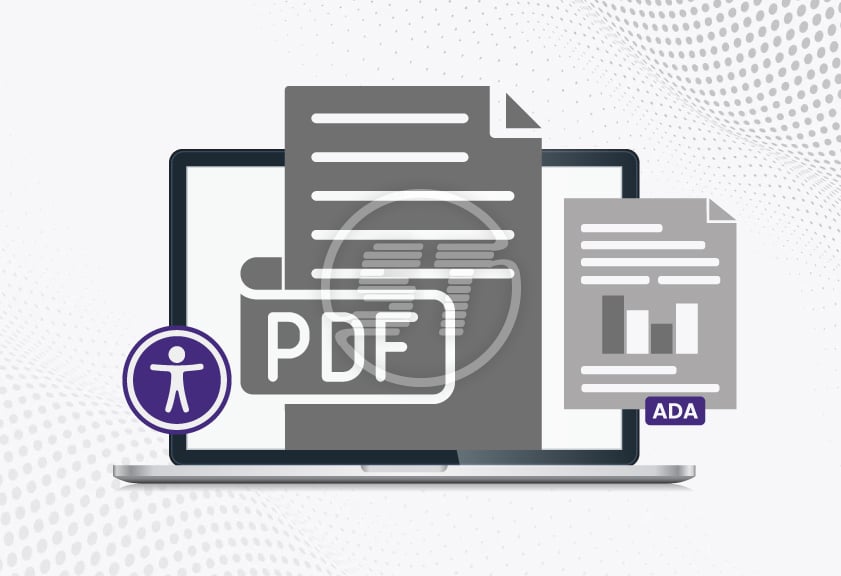In a world increasingly reliant on digital communication, ensuring accessibility for all is a legal mandate and a moral responsibility. For millions of individuals with disabilities, inclusive content means the difference between active participation and exclusion in our digital society.
PDF documents, widely used across industries, are often the linchpins to the Americans with Disabilities Act (ADA) and the Web Content Accessibility Guidelines (WCAG) 2.1 and 2.2 Level AA, these essential files risk alienating users with visual, auditory, or cognitive impairments.
By achieving PDF ADA compliance, organizations not only fulfill legal obligations but also contribute to the overarching goals of WCAG 2.1 – creating equitable, user-friendly digital experiences for everyone. This article explores how aligning PDFs with these standards strengthens accessibility, fosters inclusivity, and ensures a seamless user journey for individuals navigating digital platforms with assistive technologies.
Understanding PDF ADA compliance and PDF/UA
PDF ADA Compliance
PDF ADA compliance refers to ensuring that PDF documents adhere to the accessibility requirements of the Americans with Disabilities Act (ADA). These standards are designed to make digital content usable for individuals with disabilities, ensuring equal access to information.
An ADA compliant PDF is structured to work seamlessly with assistive technologies like screen readers, magnifiers, and keyboard navigation, enabling users with visual, auditory, motor, or cognitive impairments to access and interact with the content effectively.
PDF/UA
PDF/UA (Universally Accessibility) is an international standard (ISO 14289) specifically developed to ensure PDF documents are universally accessible. It provides guidelines and technical specifications for creating PDFs that can be easily accessed and interpreted by assistive technologies.
The purpose of PDF/UA is to establish a benchmark for accessible PDF documents, promoting inclusivity and usability for all users, regardless of their abilities.
Primary characteristics of accessible PDFs by meeting required standards!
- Tagged structure
Ensures the document is structured with headings, paragraphs, lists, and tables, enabling accessible navigation for assistive technologies.
- Text alternatives
Includes alternative text for images and non-text content to convey meaning to users with visual impairments.
- Logical reading order
Ensures content flows logically and is understandable when read with a screen reader.
- Keyboard accessibility
Allows users to navigate and interact with the document without relying on a mouse.
- Color contrast
Uses sufficient contrast between text and background to enhance readability.
- Descriptive links
Provides meaningful link text rather than vague terms like “click here”.
- Embedded fonts
Includes fonts within the PDF to ensure consistent appearance across devices.
- Forms accessibility
Makes interactive elements, such as form fields, accessible and labeled properly for assistive tools.
Here’s a PDF Accessibility Checklist to ensure ADA and WCAG compliance for PDF accessibility according to PDF/UA standards. To achieve accessibility goals, WCAG's four basic principles need to be adhered to.
The four principles of POUR
The Web Content Accessibility Guidelines (WCAG) are organized around four foundational principles, abbreviated as POUR:
- Perceivable: Information and user interface elements must be presented in ways users can perceive, regardless of their sensory abilities. For PDFs, this involves alt text for images, proper headings, etc.
- Operable: Users must be able to navigate and operate the document using different methods. Accessible PDFs ensure that interactive elements like buttons and forms are functional.
- Understandable: Content and controls should be easy to comprehend. Accessible PDFs use clear language, logical structure, and consistent navigation patterns.
- Robust: Content must be compatible with various assistive technologies and adaptive tools. Following PDF/UA and WCAG standards ensures long-term compatibility and usability.
So, WCAG 2.1 level AA standards help acquiring desired accessibility status. But why Level AA is critical for accessibility?
Well, Level AA of WCAG 2.1 strikes a balance between inclusivity and practicality, ensuring that web content and digital documents like PDFs are accessible to a broad range of users with disabilities.
- Addresses the needs of most users.
- Improves usability across devices and assistive technologies.
- Legal and regulatory compliance.
- Ensures a more inclusive user experience.
- Sets a realistic, achievable standard.
- Fosters digital equity.
Benefits of aligning PDF ADA compliance with WCAG 2.1 and 2.2
Aligning WCAG 2.1 and PDF ADA delivers significant benefits to organizations and users alike.
- Enhances accessibility for every user
The alignment ensures documents are usable by a range of users with disabilities including visual impairments, motor impairments, and cognitive disabilities. Facilitates keyboard and voice navigation, offers clear structure with readable content, and focuses on screen reader compatibility.
- Improves user experience
Accessibility features aligned with WCAG 2.1 not only help users with disabilities but also enhance the overall experience for everyone, including those with situational challenges (for instance, low-light conditions or noisy environments).
- Ensures legal compliance
Many accessibility laws and regulations, including the Americans with Disabilities Act (ADA), Section 508, and the European Accessibility Act, use WCAG 2.1 Level AA as the standard for compliance. Thus, this alignment helps organizations avoid lawsuits and penalties, meet procurement and public sector accessibility requirements, and build a reputation for legal and ethical responsibility.
- Expands audience reach
Accessible PDFs ensure that the content is usable by the approximately 15% of the global population living with disabilities. By addressing accessibility barriers, organizations can broaden their audience and build trust with diverse user groups, including employees, customers, and stakeholders.
- Builds brand reputation and inclusivity
Demonstrating a commitment to accessibility strengthens the organization’s reputation as socially responsible and inclusive. This proactive approach fosters goodwill and positions the brand as a leader in digital equity and user-first design.
- Future-proofs digital content
PDFs aligned with WCAG 2.1 and 2.2 standards are designed to remain accessible as technology evolves. By adopting these standards, organizations ensure their content stays compatible with a wide range of assistive technologies and future platforms, reducing the need for costly updates.
- Boosts efficiency and collaboration
Accessible PDFs promote seamless interaction between users and content. For example:
- Employees with disabilities can efficiently interact with work-related documents.
- Clients or partners using assistive technologies can navigate reports and contracts easily.
- Enhances SEO and searchability
WCAG 2.1 compliance often overlaps with best practices for search engine optimization (SEO). Tagged structures, descriptive metadata, and alt text enhance content discoverability, ensuring that accessible PDFs perform better in search results.
- Supports language translation capability improvements
Accessible PDFs with structured content, alt text, and properly tagged elements improve the accuracy of machine translation tools. This ensures that:
Screen readers can accurately interpret and translate content.
Multilingual users receive better, more contextually accurate translations.
Global accessibility is improved, making content usable across diverse linguistic backgrounds.
- Aligns with Corporate Social Responsibility (CSR) goals
Focusing on accessibility aligns with CSR initiatives by fostering inclusivity and equal access. This approach not only fulfills ethical obligations but also resonates with socially conscious consumers and stakeholders.
- Reduces technical debt and rework
Creating accessible PDFs from the start prevents costly rework to fix non-compliance issues later. It ensures that content is accessible upon release, saving time and resources in the long run.
Steps to Achieve PDF ADA Compliance
- Proactive design best practices
Before converting a file to PDF, ensure the source document (Word, PowerPoint, etc.) is structured correctly.
When exporting from Word or other programs, always check the “Enable Accessibility and Reflow” or “Create Tagged PDF” option.
Use the Accessibility Checker in Adobe Acrobat Pro to identify accessibility issues. Tools > Accessibility > Full Check.
Add or edit PDF tags for proper structure.
Ensure proper reading order and add alternative text to images.
Focus on keyboard accessibility, table accessibility, color contrast, form accessibility, etc.
Add document metadata. File > Properties > Description.
Test with assistive technologies (JAWS, NVDA, VoiceOver).
Use accessibility tools like Adobe Acrobat Pro’s Accessibility Check, PAC 2021, or JAWS/NVDA to validate PDF usability.
Regularly review and update PDFs to maintain compliance.
- Remediation of existing PDFs
Remediating existing PDFs ensures they meet WCAG 2.1 and 2.2 Level AA, PDF/UA, and ADA compliance standards, making them accessible to individuals with disabilities. The remediation process involves fixing tags, reading order, alt text, forms, and navigation to enable compatibility with assistive technologies like screen readers.
Perform an initial accessibility check before making changes. For Adobe Acrobat Pro users, go to Tools > Accessibility > Full Check to generate a report.
Ensure the PDF is tagged.
Correct the reading order. Open Tools > Accessibility > Reading Order.
Add or edit alternative text for non-text elements.
Fix tables for accessibility. Select the Table > Right Click > Table Editor.
Ensure proper navigation and links.
Improve the color contrast ratio by 4.5:1 for the text and background.
Fix fillable forms for accessibility. Use Tools > Prepare Form, check if each field has a tooltip label, and set a logical tab order.
Embed fonts to prevent rendering issues. Go to File > Properties > Fonts to check font embedding.
Add metadata for better document identification.
Recheck accessibility and validate the PDF by running Full Accessibility Check (Adobe Acrobat Pro).
Save and offer a downloadable PDF.
- Leverage professional PDF accessibility remediation services
Achieving PDF ADA compliance can be complex, requiring expertise in WCAG 2.1, PDF/UA, and Section 508 standards. Professional accessibility services help organizations efficiently remediate PDFs ensuring compliance while saving time and resources.
The professionals have teams of experts and access to advanced tools, which help organizations meet their PDF accessibility requirements faster without compromising on quality. Moreover, professionals can process hundreds or thousands of PDFs efficiently. Explore our accessible document remediation services.
In a nutshell,
Ensuring PDF ADA compliance plays a crucial role in strengthening WCAG 2.1 and 2.2 Level AA accessibility goals by making digital content more inclusive, usable, and legally compliant. Tagging, logical reading order, keyboard navigation, and other implementations help organizations create PDFs that are compatible with assistive technologies and accessible to individuals with disabilities.
As digital accessibility continues to evolve, businesses, government agencies, and educational institutions must prioritize PDF accessibility to foster inclusivity and equal access for all users.
So, have you checked all the digital assets of your website including PDFs? Ensuring PDFs are ADA compliant isn’t just about meeting legal requirements - it’s about making content accessible to everyone. By aligning with WCAG 2.1 and 2.2 Level AA standards, enhance readability, usability, and inclusivity for all users, including those with disabilities. Our PDF ADA compliant remediation services help to eliminate accessibility barriers, ensuring PDFs are structured, tagged, and navigable for screen readers. Reach out [email protected] for more information.
FAQs
- Why is PDF ADA compliance important?
PDF ADA compliance ensures that digital PDFs are accessible to individuals with disabilities, following standards like WCAG 2.1, PDF/UA, and Section 508. This is important because it allows users with visual, cognitive, and motor impairments to navigate, read, and interact with PDFs using assistive technologies.
- How does PDF ADA compliance align with WCAG 2.1 level AA standards?
PDF accessibility follows WCAG 2.1 level AA by ensuring PDFs meet the POUR principles and enhance usability for people with disabilities.
- What are the key features of an accessible PDF?
An accessible PDF should include the following:
- Accurate tagging structure (headings, paragraphs, lists).
- Alternative test for images and non-text content.
- Correct reading order for screen readers.
- Descriptive hyperlinks
- Keyboard accessibility
- Embedded fonts to maintain text readability.
- How can I check if my PDF is ADA-compliant?
Use tools like:
- Adobe Acrobat Pro Accessibility Checker (Tools > Accessibility > Full Check).
- PAC 2021 (PDF Accessibility Checker) for PDF/UA validation.
- JAWS or NVDA screen readers to test real-world usability.
- WebAIM Contrast Checker for color contrast verification.
- What are the consequences of non-compliant PDFs?
Failure to ensure PDF ADA compliance can lead to:
- Legal risks
- Exclusion of users with disabilities
- Lower search engine rankings
- Negative brand perception
- How long does it take to remediate a PDF for accessibility?
The timeframe depends on the complexity and number of PDFs. Simple documents may take a few hours, while larger files with intricate layouts may require more time. Contact us for an estimated turnaround.
- How can your PDF ADA Compliant Remediation Services help?
Our expert remediation team ensures your PDFs meet ADA and WCAG 2.1 Level AA standards by:
- Auditing existing PDFs for accessibility gaps
- Fixing structural and tagging issues
- Enhancing usability for assistive technologies
- Delivering WCAG compliant, and user-friendly documents
- Do you offer bulk PDF ADA remediation services?
Yes! We provide bulk PDF accessibility remediation for businesses, educational institutions, government agencies, and other organizations needing large-scale compliance solutions.
- How can I get started with PDF WCAG accessibility remediation services?
Simply request a free quote, our team will evaluate and get back to you. You can also reach out at [email protected].


